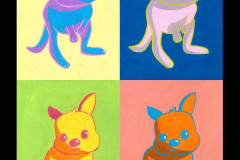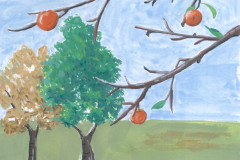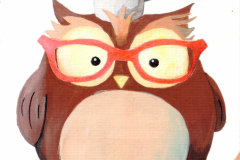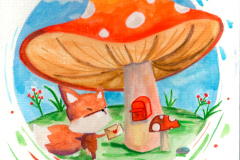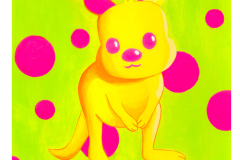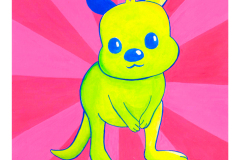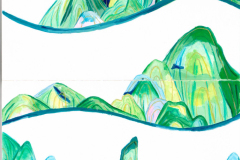Introduction
Gouache painting offers unique possibilities for artists interested in creating vibrant, opaque colors and textured effects. This paint combines the qualities of watercolor and acrylics, allowing you to layer colors with ease and incorporate diverse materials. Understanding the qualities of gouache helps unlock new creative paths in abstract and mixed media art. You can use gouache not only with brushes but also with unconventional tools to produce distinct textures and effects. This versatility makes it ideal for experimental and mixed media approaches where layering and opacity are crucial.
Exploring gouache painting ideas opens opportunities to refine your artistic skills and develop your own style. Whether you aim to create bold abstract works or integrate gouache into collage and mixed media, you will find practical suggestions here. This article guides you through techniques to work with gouache effectively and introduces creative concepts that stimulate your artistic process. You will learn how to achieve depth and contrast, use gouache with other mediums, and harness abstract styles to make impactful art.
Understanding Gouache and Its Unique Properties
Gouache is a type of water-based paint known for its thick, creamy texture and solid, bright colors. It differs from its cousins like watercolor and acrylic by offering full opacity, which means you can layer it without colors underneath showing through. Unlike watercolor, gouache dries to a matte finish that reflects little light, giving your artwork a rich, velvety look.
This paint contains more pigment and denser binders, making it less transparent and easy to correct. Its ability to be reactivated with water even after drying can save you from mistakes or allow you to create soft blends. Artists enjoy using gouache because it adds bold blocks of color and texture, ideal for abstract mixed media pieces where layering and contrast matter.
Have you ever struggled with the translucency of watercolor or the plastic-like finish of acrylic? Gouache offers a middle ground that supports creativity and flexibility, especially when combined with other materials like collage or ink. This balance makes gouache a useful tool to expand your artistic possibilities.
Gouache Composition and Visual Effects
Gouache paint mainly consists of pigments, binders like gum arabic, and fillers such as chalk or white clay. The pigments provide color and intensity. Binders hold the pigment together and help the paint stick to surfaces. Fillers increase opacity and thickness, giving gouache its heavy, solid feel upon drying.
The visible matte finish results from these fillers diffusing light rather than reflecting it, so colors appear softer and less shiny. This quality lets you build solid shapes and opaque layers without glare, which often challenges mixed media artists looking for flat color areas. These ingredients let you paint clean surfaces ready for additional textures like ink lines, torn paper, or pastels.
Comparing Gouache with Other Paints
Gouache shares watercolor’s water-solubility, but it behaves differently. While watercolor is transparent and requires careful layering, gouache covers previous layers completely. Acrylic paint is also opaque like gouache but dries to a glossy and plastic-like surface that can feel stiff. Gouache retains softness once dry, which suits mixing with delicate papers or charcoal.
Handling gouache lets you fix mistakes easily since you can add water to rewet dried areas and lift or blend paint. Acrylics dry fast and cannot be reworked this way. Watercolor demands skill to control wetness to avoid unintended runs or blooms. If your work combines painting, drawing, and collage, gouache’s unique mix of opacity, reactivation, and matte texture can give you more control and variety.
Essential Tools and Surfaces for Gouache Painting
Choosing the right tools can change how your gouache paintings turn out. The brushes you use affect the texture and detail of your abstract mixed media work. You can use round brushes of various sizes for controlled lines or flat brushes to cover larger areas quickly. Synthetic brushes usually hold their shape longer when working with thick gouache. For creative effects, try sponges to dab paint or palette knives to scrape and layer colors in unexpected ways.
Paper and surface choice really impacts the final result. Thick papers with textures like cold-pressed watercolor paper give your paint something to grip. For mixed media, heavier or coated papers can handle multiple layers and materials without warping. For example, hot-pressed papers provide a smooth surface if you want sharp shapes, while rougher papers add texture that interacts with your paint. Consider experimenting with canvas boards or heavyweight paper designed for acrylics to add durability for mixed media pieces.
Have you tested how different surfaces respond when you layer gouache with inks or collage materials? Finding the right match lets you build richer, more dynamic abstract paintings that hold up during creative experimentation.
Selecting the Right Brushes and Tools
Not all brushes work the same with gouache, especially in abstract mixed media. Round brushes with fine points let you add small details and lines. Flat brushes help fill larger areas or create sharp edges. Synthetic bristles often last longer and handle gouache’s thick texture better than natural hair.
Sponge pieces offer a soft way to apply or lift paint, making gentle textures or blending smooth patches. Palette knives let you scratch into wet paint or lift off dry paint layers, revealing colors beneath. You can even use old credit cards or stiff cardboard to drag paint and create unique, uneven effects.
Ask yourself what textures or marks you want before choosing a tool. Do you want clean shapes, rough strokes, or soft gradients? Keep a small set of versatile brushes and alternative tools in your kit to keep trying new approaches with gouache.
Choosing Papers and Surfaces for Mixed Media
Your surface needs to support both gouache and the other media you add. Choose heavyweight watercolor paper (300 gsm or more) to safely add layers of paint, ink, or collage without buckling. Cold-pressed paper offers a nice texture for paint to catch on, but hot-pressed paper works well if you prefer smooth brush strokes.
Mixed media papers made for acrylics or pastels can work with gouache too, giving you durability. Canvas boards also provide a solid base when you want to combine textures like fabric, thread, or gel mediums. If you work with wet and dry layers, stiff supports like illustration board allow easier reworking without damage.
What surface qualities help your style? Try samples on different papers to observe how gouache layers, dries, and interacts with other materials. This testing helps you choose surfaces that improve your abstract mixed media paintings.
Basic Gouache Techniques for Abstract Art
Mastering basic gouache techniques is essential to create rich, dynamic abstract mixed media art. Start by practicing layering, which helps build depth and complexity. Apply thin washes of color first and wait for them to dry before adding more layers. Each layer can be more opaque or transparent depending on your needs, giving you control over the final intensity and mood.
Blending colors while gouache is still wet creates smooth transitions that enhance flow and movement. Try using a damp brush to softly merge two tones on your surface. You can experiment with gradual blending or sharper edges based on your vision. Controlling opacity here plays a key role—thinner layers reveal underlying colors, while thicker paint creates solid forms.
In abstract art, texture drives interest. Using dry brush techniques introduces subtle texture and visible brush strokes that contrast with smooth areas. Lightly drag an almost dry brush loaded with paint over your paper to create fine, scratchy marks. Mix dry brushing with other texture methods like splattering and scraping to add complexity and surprises to your work.
Applying Layers and Blending Colors
Layering in gouache means painting multiple coats that interact visually. Start with light, diluted layers and let them dry before adding denser coats. This builds depth without muddying colors. Consider the drying time between layers to avoid unwanted mixing.
Blending colors demands balance. Use a clean, damp brush to blend wet paint edges carefully. Avoid overworking the paint, which dulls colors. Experiment by blending warm and cool hues to create unique gradients or transition zones.
Think about opacity as your tool. Adding water thins your paint and lets previous layers shine through. With less water, expect more coverage. How can you use this to highlight certain areas without losing the transparent quality?
Using Dry Brush and Texture Techniques
Dry brushing creates scratchy textures that catch light and add interest. Load a brush with thick paint and remove extra moisture by wiping it on a cloth. Then sweep it lightly over textured paper for streaky lines. This works great to suggest movement or rough surfaces.
Combine dry brushing with other texture methods like splattering paint with a toothbrush or tapping with a sponge. Each technique adds layers of visual complexity. Try scraping through semi-dry paint with a palette knife to reveal underlying colors.
Ask yourself: How can these textures interact with smooth painted areas to strengthen my composition? Use textural contrast deliberately to guide the viewer’s eye and create focal points in your abstract pieces.
Incorporating Mixed Media Elements with Gouache
Combining gouache with other materials can transform your abstract artwork and add new layers of interest. Using collage pieces, pastels, and ink introduces texture, contrast, and unexpected details. When you place paper or fabric on top of a dried gouache base, the differences in surface and tone create depth beyond paint alone. Try experimenting with transparent papers or textured fabrics to see how they influence your color and light perception.
Adding ink or pastel marks on top of gouache lets you focus your composition. Ink lines or pastel smudges can define shapes or suggest movement. These mixed media layers invite your eye to explore the image more closely. You might ask yourself: which materials highlight the ideas I want to express? How can each medium interact to support my abstract vision?
Collage and Found Objects in Gouache Art
Start by choosing lightweight collage elements such as paper, fabric scraps, or even thin leaves to attach on your gouache painting. Use a clear drying glue that won’t disturb the paint underneath. Apply the adhesive sparingly to avoid wrinkles or bubbles. Press the materials gently to blend them flat.
To integrate these pieces smoothly, paint over edges with gouache matching your background tones. This step connects the collage to the painted surface. You can also layer translucent paints over parts of the collage to soften the contrast. Experiment with tearing paper instead of cutting for organic shapes that add interest to your composition.
Using Pastels and Inks for Detail and Contrast
After your gouache layer has fully dried, apply pastel or ink to build detail and contrast. Soft pastels work well for blending color and creating hazy or glowing effects. Use your fingers or a blending tool to diffuse the pastel into the paint.
Ink adds sharp, graphic lines that stand out against gouache’s matte texture. Try using fine liners or brushes to draw precise marks. Layer multiple ink strokes for texture or varied weight. When layering, be sure the gouache beneath is dry to avoid smearing. Think about how subtle pastel shadows and bold ink lines can play together to enhance your abstract shapes and bring balance to your work.
Color Theory and Composition in Abstract Gouache Painting
Selecting Color Palettes to Build Mood
Color choice shapes the feeling of your abstract gouache pieces. Warm colors like reds and oranges can evoke energy or tension, while cool blues and greens often bring calm or distance. You can use the color wheel to find harmonious combinations, such as complementary colors that create vibrant contrast or analogous colors that blend smoothly.
Think about how the opacity and matte finish of gouache affect color intensity. Layering semi-transparent colors changes moods in subtle ways. Ask yourself: What emotion do I want to express? Are my colors supporting that mood or fighting it?
Try limiting your palette to two or three colors. This restraint can clarify your message. Experiment with mixing tints and shades of your chosen colors to expand variety without losing cohesion. You control the emotional impact by how you combine colors, so be deliberate in your selection.
Composing Balanced and Dynamic Abstract Works
Composition drives how your viewer’s eye moves across the painting. Use shapes, lines, and color blocks deliberately to balance the space. Unequal visual weight can create tension or movement. Ask: Where should the eye rest? Where should it be pulled?
Place focal points off-center for dynamic tension. Repeat shapes or colors to create rhythm and connection. Consider negative space as a tool to prevent clutter and let elements breathe.
Experiment with layering gouache washes and solid areas to guide attention through your work. Adjust composition before adding final details. Sometimes shifting a shape or hue slightly changes the whole feeling of balance. Composition and color work together to make your abstract art feel complete and alive.
Creative Experimentation with Gouache Effects
You can add energy and texture to your gouache paintings by trying techniques beyond normal brushwork. Scratching into wet or dry paint creates interesting marks that break up flat colors. Use a toothpick or the edge of a palette knife to gently scratch lines or shapes. This technique works well for adding depth or making parts of your painting stand out.
Spattering paint is another way to build lively textures. Flick a stiff brush loaded with gouache onto your painting surface to create small dots and splashes. You can vary the size and density by adjusting how much paint is on your brush and the distance from the paper. This adds motion and randomness to your abstract art.
Have you tried combining scratching and spattering? Creating layers with these effects changes the feel of your work, making it more dynamic. Ask yourself where these textures could enhance your composition or create a focal point.
Creating Texture Through Scratching and Spattering
Scratching removes paint to reveal underlying layers or paper, adding contrast. Start by applying a thick layer of gouache and let it dry slightly. Then drag a pointed tool through the paint. You might find straight, jagged, or circular lines that give your painting a tactile quality.
Spattering requires control for the best results. Dip a brush in gouache thinned down with water, then tap it against your finger or a stick over the painting. Keep your hand steady and adjust the angle to control where the spots land. This creates energy and unpredictability, ideal for abstract compositions.
Try creating texture grids by spattering over scratched patterns. Notice how light reflects differently on varied surfaces. What new feelings can these textures bring to your piece?
Using Alternative Tools for Unique Patterns
Beyond brushes, use household items to achieve original gouache effects. Combs produce parallel lines or wave patterns when pulled through wet paint. Sticks, old credit cards, and even feathers make distinctive marks and shapes.
Experiment with pressing and dragging these tools on wet gouache to form patterns impossible with traditional brushes. For example, dragging a comb through a thick layer can imitate ripples or abstract landscapes in your work.
Ask yourself which textures or patterns will best express your artistic intent. Using unexpected tools encourages fresh ideas and can make your mixed media pieces feel more personal and unique.
Maintaining and Preserving Gouache Artworks
Drying and Handling Gouache Paintings
Gouache dries quickly, but rushing the process can cause cracks or uneven textures. Allow your paintings to dry on a flat surface away from direct sunlight or heat sources. This helps prevent rapid drying that may lead to surface cracking. If your artwork includes thick layers or mixed media, expect longer drying times and consider drying in stages.
Handle your gouache pieces carefully. Wet gouache remains water-soluble, so avoid touching or moving the painting right after finishing. Use a clean palette knife or brush to test dryness gently. If you want to add more layers, wait until the current layer fully dries to keep colors vibrant and prevent muddiness. Have you noticed small cracks or peeling? These usually come from thick paint layers drying too fast or on uneven surfaces. Try working thinner and more gradually.
Protecting Finished Works for Longevity
Once fully dry, protect your gouache art to keep colors fresh. Unlike oils or acrylics, gouache isn’t waterproof. Consider using a matte spray varnish made for water-based paints. Test it on a sample before applying to avoid yellowing or altering texture. Avoid glossy finishes unless you want a shiny effect.
Framing behind UV-protective glass helps reduce fading from light exposure. Make sure to mount the painting without pressing the glass onto the surface. Using a spacer or mat keeps the artwork safe from condensation or sticking.
For storage, keep your paintings flat and away from humidity. Store artworks separately or with acid-free paper between pieces to prevent smudging or damage. Do you have unfinished gouache layers on mixed media? Cover them gently with wax paper until you continue working.
Inspiring Ideas to Start Your Abstract Gouache Project
Ideas can come from many places when you begin an abstract gouache project. One way to start is by observing your environment closely. Look for patterns, shapes, or colors that catch your eye. Ask yourself how you might break down these elements into simple forms or textures using gouache. For example, the rough surface of a tree bark or the rhythm of city streets can become the foundation of your design.
Another idea is to use a limited color palette to focus on contrast and shape. You might try painting layers with gouache, then add other materials like paper or fabric for texture. Challenge yourself to mix smooth areas with bold brushstrokes. Such juxtapositions create interest in abstract mixed media work.
Ask what you want your artwork to communicate. Is it a feeling, a memory, or a concept? Choosing a clear goal helps guide your choices in composition and materials. Soon, you’ll find exciting ways to begin your abstract gouache painting with confidence and purpose.
Using Nature and Urban Environments
Nature and city scenes provide rich sources for abstract art. Notice the shapes formed by leaves, branches, or clouds. How could you simplify those shapes into geometric or organic forms using gouache? Consider the colors found in nature, such as the earthy browns of soil or the soft greens of moss. Try layering these hues and blending edges to create depth.
Urban settings offer textures and lines worth exploring. Broken pavement cracks, graffiti marks, or reflections on glass can inspire interesting patterns. You might paint a series based on street views but alter shapes and colors to make them more abstract. Use masking techniques or stencils to mimic architectural details without recreating them exactly.
Try carrying a small sketchbook to capture quick impressions while outside. Later, you can use these sketches as starting points for your gouache paintings. This direct engagement with your surroundings can bring fresh ideas to your abstract work.
Transforming Emotions and Concepts into Art
Your feelings and ideas offer powerful fuel for abstract gouache paintings. Instead of trying to depict a scene, focus on expressing an emotion or concept through shapes and colors. For example, if you feel tension, sharp angles and dark hues might communicate that. Calm may come through soft blends of blues and flowing forms.
Try setting a mood before you paint. Close your eyes and recall specific experiences or feelings. Then, choose your colors based on those emotions. Let the gouache guide your brush without strict plans. Notice how changing pressure or stroke direction alters the mood of your work.
This method helps you tap into personal expression. It also allows flexibility in your mixed media approach. You could combine gouache with charcoal marks that suit the feeling or add textured paper to represent complexity. How can you use abstract shapes to communicate what words cannot?
Conclusions
You now have a clear understanding of how gouache suits abstract mixed media art and various painting techniques that enhance creativity. These ideas encourage you to experiment with layering, opacity, and texture. You can mix gouache with different materials such as collage elements, pastels, or inks to create interesting effects. Using gouache as a base or detail element expands your artistic toolkit. Your safe approach to imperfections during the process also adds charm and unique qualities to your final piece.
Continued practice and exploration will refine your skill in handling gouache while developing your personal style in abstract art. Keep focusing on practical techniques that produce desired visual outcomes. Ask yourself how to balance bold colors with textures, and how to merge mediums to enhance your compositions. By integrating these ideas into your practice, you will make meaningful progress in your gouache paintings and mixed media projects.


















